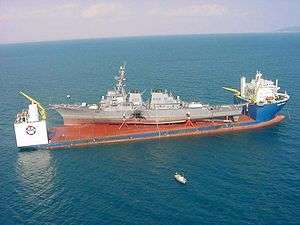Heavy-lift ship


A heavy-lift ship is a vessel designed to move very large loads that cannot be handled by normal ships. They are of two types: semi-submerging vessels capable of lifting another ship out of the water and transporting it; and vessels that augment unloading facilities at inadequately equipped ports.
History
In the 1920s, the Bremen-based shipping company DDG Hansa saw a growing demand of shipments for assembled locomotives to British India. That led to the construction of the world's first heavy lift vessel, SS Lichtenfels with a 120 t (118 long tons; 132 short tons) derrick.[1] After World War II, DDG Hansa became the world's largest heavy lift shipping company. In terms of lifting capacity it reached its peak in 1978 with refitting the Japanese built bulk carrier MV Trifels with two 320 t (315 long tons; 353 short tons) Stülcken derricks. Shortly after that, in 1980, DDG went bankrupt. With that, only the Dutch shipping companies Jumbo, BigLift Shipping (until 2001 named Mammoet Shipping) and SAL Heavy lift [2] were left as heavy lift shipping specialists.
Submerging types
Semi-submerging are more commonly known as a "flo/flo" for float-on/float-off. These vessels have a long and low well deck between a forward pilot house and an aft machinery space. In superficial appearance, it is somewhat similar to a dry bulk carrier or some forms of oil tanker. Its ballast tanks can be flooded to lower the well deck below the water's surface, allowing oil platforms, other vessels, or other floating cargo to be moved into position for loading. The tanks are then pumped out, and the well deck rises to shoulder the load. To balance the cargo, the various tanks can be pumped unevenly.
The flo/flo industry's largest customer base is the oil industry. They transport many oil drilling rigs (flo/flo ships can carry the rigs from their construction site to a drilling site at roughly three to four times the speed of a self-deploying rig). Rapid deployment of the rig to the drilling site can translate into major savings. They also transport other outsized cargo and yachts.
The U.S. Navy has used such ships to bring two damaged warships back to the United States for repair. The first was the guided missile frigate USS Samuel B. Roberts, which was nearly sunk by a naval mine in the central Persian Gulf on 14 April 1988. The frigate was towed to Dubai, then floated home to Newport, Rhode Island, aboard Mighty Servant 2.[3]
Eleven years later, MV Blue Marlin transported the U.S. guided missile destroyer USS Cole from Aden, Yemen to Pascagoula, Mississippi, after the warship was damaged in a bombing attack on 12 October 2000.
The U.S. Navy has also chartered other heavy lift ships to carry smaller craft, usually mine-countermeasure craft, or other patrol craft. Since there are no US-flagged heavy lift/flo/flo ships, the U.S. Navy normally relies on its Military Sealift Command to charter them from the world commercial market.
In 2004, Blue Marlin carried the world's largest semi-submersible oil platform, BP's Thunder Horse PDQ, from the Daewoo Shipbuilding & Marine Engineering (DSME) shipyard in South Korea to Kiewit Offshore Services in Ingleside, Texas.[4]
Many of the larger ships of this class are owned by the company Dockwise, including Mighty Servant 1, MV Blue Marlin, and MV Black Marlin. In 2004, Dockwise increased the deck width of Blue Marlin, to make it the then-largest heavy transport carrier in the world until it was superseded by the launch of the Dockwise Vanguard in 2012. One of the company's vessels, Mighty Servant 2, capsized after hitting an uncharted underwater obstacle off Indonesia in November 1999.
References
- ↑ "Lichtenfels". DDG Hansa:. Retrieved 23 May 2010.
- ↑ "SAL Heavy Lift – We Innovate Solutions - Home". sal-heavylift.com.
- ↑ "No Higher Honor: USS Roberts Aboard Mighty Servant II". Navybook. 2010. Retrieved 23 May 2010.
- ↑ "Projects: Thunder Horse PDQ". Dockwise. 2010. Retrieved 23 May 2010.
External links
| Wikimedia Commons has media related to Heavy-lift ships. |
